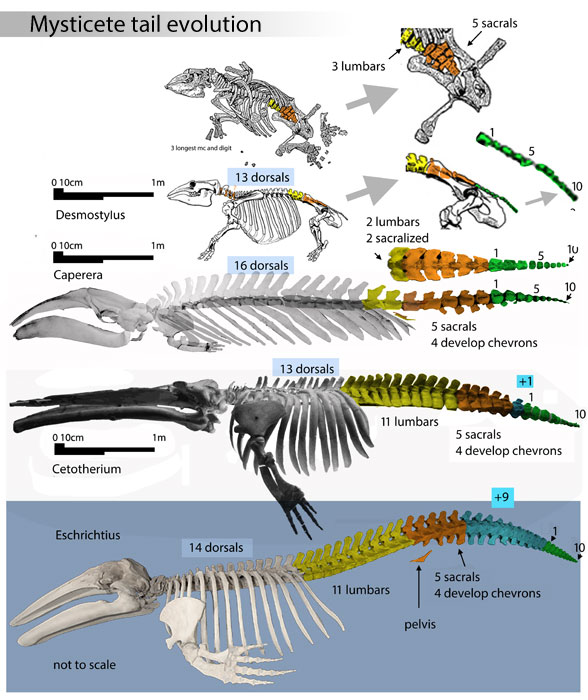According to
the large reptile tree (LRT, 2292 taxa) three clades of placental mammals developed horizontal flukes (= tail fins) and lost their hind limbs as they independently ventured into the sea.
We’ll start with the easy one first, the one that everyone agrees upon.
The origin of tail flukes in sirenian (sea cow) ancestors
follows a gradual lengthening of the caudal vertebrae from short and vestigial in Moeritherium to long and powerful in Dusisiren (Fig 1). Hind limbs disappeared after Prorastomus. The number of lumbar vertebrae remained steady and less flexible at 3-4 after Procavia. The number of sacral vertebrae remained steady at 2-3. The number and size of caudal vertebrae rose over time. Transverse processes became exceptionally wider in sirenian lumbars, sacrals and caudals.

The origin of tail flukes in odontocete (toothed whale) ancestors
follows a different evolutionary path (Fig 2) starting with extant elephant shrews (Rhynchocyon) and moles (Talpa). Here the originally long, slender tail was retained by amphibiious Pakicetus and then became a relatively shorter, but more robust propulsive organ with large transverse processes in Maiacetus. The hind limbs disappeared thereafter. The long and flexible lumbar number remained higher than 7. The sacral number varied from 4 to 2, then back to 4 in Maiacetus, then back to 2 in Dorudon.
Exceptionally, extant tenrecs have vestigial tails.
Note the artiodactyl-like ankle joints in Rhynchocyon and Indohyus (Fig 2). That was the source of the confusion that allied fossil archaeocetes to artiodactyls (Thewissen et al 2001, 2007), again due to taxon exclusion. The LRT minimizes taxon exclusion.

The origin of tail flukes in mysticete (baleen whale) ancestors
follows a third evolutionary pathway (Fig 3) in the LRT. In this lineage desmostylians with vestigial tails and large hind limbs developed into mysticetes with large robust tails and absent hind limbs. The lumbar number stayed at 2 as four-limbed Desmostylus evolved into flipper and fluked Caperea. Thereafter the lumbar region added vertebrae and flexibility. The sacral number seems to have remained constant at 5 in every taxon, but became flexible with the loss of the pelvis and hind limbs. The number of tail vertebrae also remained constant at 10. One additional vertebrae appeared between the sacrals and caudals in Cetotherium. Eight more appear in the gray whale, Eschrichtius.
Note the large, but diminishing transverse processes on the last lumbar and five sacrals that continue to diminish on the tiny caudals.

Chevrons
appear beneath bony fish tail vertebrae. Thus the disappearance of chevrons in various tetrapods is a derived and a convergent trait.
In the mammal lineage chevrons disappeared between the cynodonts Thrinaxodon and Chiniquodon.
In marine mammals with flukes chevrons reappeared
as muscle anchors that powerfully flex the caudal series for propulsion, a reversal to fish, but now up-and-down, rather than side-to-side. The hind limbs became useless and disappeared.
In sea cow ancestors (Fig 1) chevrons were primitively absent. Tiny chevrons reappeared only below the distal tail vertebrae in Dusisiren. Sea cows are slow-moving herbivorous swimmers.
In toothed whale ancestors (Fig 2) chevrons were also primitively absent. Robust chevrons reappeared below most tail vertebra in Maiacetus other than the tiny distal few – presumably between developing caudal flukes. Robust chevrons in this pattern are retained in all descendants, all of which are powerful predatory swimmers attacking large prey one at a time.
In baleen whale ancestors (Fig 3) chevrons were also primitively absent. In Caperea chevrons reappeared below four of the five former sacrals and the first few caudals. Derived taxa add vertebrae and chevrons, but lose chevrons below the original ten caudals now located between caudal flukes. Baleen whales are also powerful predatory swimmers, attacking tiny prey engulfed en masse.
A special thank you to reader Sech
for asking about mysticete tail evolution. The process of building these diagrams (Figs 1–3) was a learning experience. These data explore several characters not scored in the LRT.
If you have any questions like this, ask them.
The number of untested taxa worth testing in the LRT is dwindling, as intended a dozen years ago when this online experiment had its genesis. Many mistakes were made when the taxon list was smaller, now corrected with a larger list and more understanding of fish skull homologies (still on the learning curve with that one).
All taxonomic questions deserve answers. The LRT can help.
The LRT tests and nests a wide gamut of taxa,
sometimes recovering novel hypotheses of interrelationships. The gaps between taxa have gotten smaller, as intended. All enigma taxa now nest with sisters, as hoped.
Even so, the LRT needs scientific confirmation, refutation or modification with a similar taxon list from independent workers using their own character list and testable .nex files. Those who label this 12-year experiment ‘pseudoscience‘ really need to present a competing cladogram. Don’t keep us waiting.
Thank you for your readership.
References
Peters D unpublished. The triple origin of whales. ResearchGate.net
Thewissen JGM et al (4 co-authors) 2007. Whales originated from aquatic artiodactyls in the Eocene epoch of India. Nature 450:1190–1194.
Thewissen JGM et al (3 co-authors 2001. Skeletons of terrestrial cetaceans and the relationships of whales to artiodactyls. Nature 413, 277–281.
